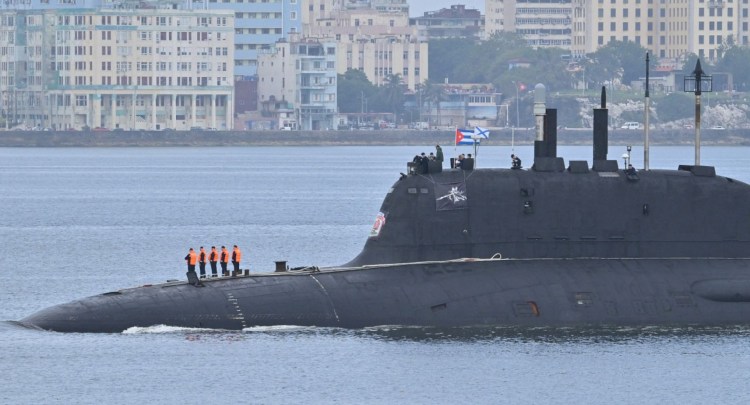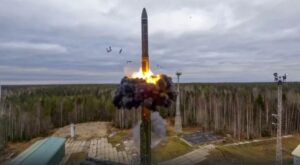This article was first published on Warrior Maven, a Military Content Group member website.
With one corroded and much-damaged aircraft carrier, which may never set sea again, and a small fleet of destroyers and surface warships, the Russian Navy is ill-equipped to project global power and operate as a substantial threat or counter to the US Navy. The Russian Navy can perhaps operate as a regional power in the Black Sea or along the Northern Sea Route with its icebreakers. The Russian Navy could possibly also present some kind of a threatening presence in the Baltic Sea … however, while the Russian Navy is likely a threat taken seriously, Russia’s surface fleet does not by any estimate pose a serious threat to US Naval supremacy. This has been the case for many years, as Russia may not have the ambition to become a dominant global naval power like the US or China.
Russian Submarines … however, present a totally different threat equation, as they not only rival the US in terms of sheer fleet size but may also be competitive when it comes to quieting technologies, firepower, nuclear-weapons delivery and even hypersonic missile attacks.
According to GlobalFirepower.com’s 2023 Military Rankings, Russia operates 70 submarines, two more than the 68 US submarines. Along with fleet size, Russia operates attack and ballistic missile submarines which are upgraded, highly lethal, steatlhy and engineered with a suite of advanced technologies. The presence of Russian submarines and the threat they pose have arguably inspired the Pentagon to push the envelope of innovation and production for its own submarine force.
Yasen, Borei, Kilo, Typhoon, Delta
1. YASEN-M — Hypersonic Missile-armed Submarines
Russia’s Yasen-M ballistic missile submarines will fire the Zircon hypersonic cruise missile by 2025 from the ocean, a development marking a potential new era in maritime warfare threats.
The first Yasen-M boat in the class to fire the weapon will be the Perm, a vessel slated for commissioning in 2024, according to Russia’s TASS news service.
“Among the nuclear submarines of project 885M, the fifth submarine Perm will be the first regular carrier of the Zircons, which will be structurally slightly different from its predecessors,” the paper quotes a source saying.
Should the U.S. Navy succeed with plans to fire hypersonic missiles from attack submarines by 2028, something Chief of Naval Operations Adm. Michael Gilday told Congress last year, they might be behind the Russian timeline, should TASS be accurate.
Yasen: A Threat Beneath the Surface
Lurking beneath the surface within striking distance of enemy territory, hypersonic missile-armed submarines would present adversaries with quite an advantage, as they could hit enemy targets on shore while remaining quite difficult to detect by enemy ground or air radar systems. A surface ship or lower-flying aircraft, by contrast, would likely be seen and known by an enemy at great distances, whereas a submarine might succeed in eluding detection and be in a position to launch surprise attacks capable of destroying high-value enemy targets from the ocean within minutes.
Overall, Russia will operate 11 Yasen-class submarines, with 10 being the modern Yasen-M variant. The first Yasen, called the Serverodvinsk, emerged 10 years ago, whereas the first Yasen-M boat, the Kazan, appeared in 2021. Russia recently announced it will build two more as-of-yet-unmanned Yasen-M submarines.
The Yasen-M boats are built with a KTP-6 Monoblock life-of-core reactor, which, while decreasing size and space, also brings quieting technologies to the submarine. The largest advantage of a life-of-core reactor, which is now being built into the U.S. Navy’s emerging Columbia-class boats, is that it enables continued operational service and deployment without having to pause for mid-life refueling.
“The new-generation reactor will also contribute to the quieting of the submarine, meaning that the Kazan may surpass the Severodvinsk in terms of its ability to evade detection,” a Rusi.org essay states.
Yet another advantage woven into the upgraded Yasen-M submarines is its conformal array sonar, which improves performance beyond the “cylindrical array sonar” on most Russian submarines. It is possible that Russian weapons developers copied U.S. Navy conformal array sonar technology built into Block III Virginia-class attack submarines in recent years.
“It allows a larger surface area for hydrophone arrays, and thus greater array gains in passive mode compared to the older spherical array sonar configuration,” Rusi.org states.
******
2. Kilo-Class
Russia’s Navy is by any account much smaller, less lethal, and much less capable of projecting global power when compared to the U.S. Navy, yet its submarines remain a serious and somewhat pressing threat for a number of critical reasons.
Enter the Kilo
Current variants of the Soviet 1980s-era Kilo-class submarine feature an improved engine, advanced combat system, and various kinds of cutting-edge noise-reduction technologies. Some in the U.S. naval community refer to this class of Russian sub as the black hole for being relatively stealthy.
While the specific extent to which it can rival the U.S. Navy’s advanced Block III and Block V Virginia-class submarines may not be fully known, the Type 636.3 Kilo-class variants are the byproduct of a series of enhancements integrated in the mid-2010s to further strengthen the boat’s anti-submarine and anti-surface-ship mission.
Over the course of several decades, the Kilo-class boats have been engineered with advanced sonar, mine-detection, and avoidance sonar.
A piece in the Diplomat says Project 636.3 is an improved variant of Project 877 Kilo-class designs, which is slightly longer and more advanced.
Enhancements likely to be of larger concern, for instance, include ceramic compounds used as “coating” materials to improve “quieting” technologies, according to a paper published by Russian weapons maker Rosoboronexport.
Such materials, called Anechoic files, are defined as tiles fitted on casings to absorb the soundwaves, resulting in a reduction and distortion of the return signal.
The Kilo-class can fire torpedoes accurately and very quickly in a window of 15 seconds, often using remote-controlled firing capability. The weapons capacity of the boats is detailed in an interesting article from the Federation of American Scientists.
“The submarine can carry 24 mines with two in each of the six tubes and twelve on the racks. Two torpedo tubes are designed for firing remote-controlled torpedoes with a very high accuracy. All torpedo tubes and their service systems provide effective firing from periscope to operational depths. The computer-controlled torpedo system is provided with a quick-loading device. It takes only 15 seconds to prepare stand-by torpedo tubes for firing: The first salvo is fired within two minutes and the second within five minutes,” the FAS paper says.
Can it Take on the U.S. Navy?
It would seem quite useful to determine the extent to which advanced 636.3 Kilo-class submarines can rival advanced U.S. Virginia-class submarines in terms of torpedo guidance, launching, and range.
Of equal importance would be the “coatings” or quieting materials surrounding the exterior of the boat, combined with quieting or enhanced propulsion technologies. The FAS essay also says the Kilo-class can deploy mines from its torpedo tubes, however, it would be quite significant to determine if, like the U.S. Virginias, the Kilos can succeed in launching drones from its torpedo tubes.
The specifics of the enhancements to Virginia-class submarines, first built into a prototype Block III boat called the USS South Dakota almost 8 years ago and have since become operational, are likely not available for security reasons. However, in a broad or general sense, Senior Navy weapons developers did say the enhancements related to antennas, coating material, and engine-quieting technologies.
Block III Virginias also have a Large Aperture Bow advanced sonar and an automated, joy-stick-controlled computerized fly-by-wire navigation system. The Kilo class is described as having some computer automation, yet it seems it would be quite significant to determine the extent to which it can truly rival cutting-edge Virginia-class submarines.
This is of particular tactical significance because advanced Virginia-class submarines are increasingly being used for Intelligence, Surveillance, and Reconnaissance (ISR) missions to survey high-risk areas such as enemy coastlines while remaining much less detectable than easy-to-see surface ships.
**************
3. Borei-class Submarines
The Russian Navy is reporting progress with its second 955A Borei-class nuclear-armed ballistic missile submarine, an upgraded boat reported by a Russian media outlet to incorporate some of the most advanced “quieting” technologies to ever exist.
Just last year, Russia deployed its first in series of at least seven upgraded Borei-A nuclear-armed ballistic missile submarines, called the 955As.
The second one, called the Knyaz Oleg, is slated to enter service in July of this year, TASS reports.
At least five more are on the way as well, according to TASS, which reports that three additional 955As are under construction and two more have been ordered.
The first of the Borei class, the 955s, were fielded as far back as 2013, however the 955As are reported to incorporate a number of technical upgrades intended to lower the submarine’s acoustic signature.
While details of these kinds of innovations are likely not available for obvious reasons, several reports point to the nature of the new quieting technologies incorporated in the 955A design.
An interesting 2017 analysis written in navyrecognition.com highlights a few of the innovations informing Russian efforts to upgrade the 955 submarines to the 955As.
The sound-adsorbing coating together with specifically located onboard equipment provides for practically noiseless combat patrol. The sound-absorbing insulation composition changes with the emergence of each submarine, as well as the method to fix it to the hull. Unique technologies for the creation of high-density substances decreased the noisiness of modern submarines over 100 times against Cold War era U-boats,” the Navy Recognition report states.
The 955As also incorporated hydraulic jets for “covert movement” and a technology called “high-duty low magnetic hull” to lower noise even further and subvert acoustic sensors seeking to track them. One TASS report even claimed the 955As were even “quieter” than U.S. Virginia-class attack submarines, something which is of course completely unverified.
The boats carry up to 16 missiles with a significant range of 9,300km, roughly equivalent to reported ranges of the China’s new nuclear armed JL-3 missiles. Both of these nuclear weapons can, depending upon strategic positioning, introduce the possibility of placing the continental U.S. at risk from considerable distances.
What the Russian report does not incorporate is any comparisons with or details of the U.S. Navy’s emerging Columbia-class nuclear armed ballistic missile submarines, new boats built with innovations which may make it the stealthiest submarine ever to exist.
Of course, many of the most impactful technologies intended to lower the boats’ acoustic signature are likely not available for security reasons; the Columbia’s are built with electric-drive propulsion, a technology which is, of course, much quieter than the legacy hydraulic system. mobile electrical power to the submarine, systems of great relevance given the large number of advanced electronics built into the submarine. Newer kinds of command and control, computerized or automated navigational systems, and electrically-powered weapons and sensor interfaces.
Yet another way to remain less detectable is through the use of missile-tube-launched undersea reconnaissance drones. Many of these drones are now being built by the Navy to bring new launch and recover surveillance systems to undersea warfare through the use of missile tubes. The technical ability to dispatch and track unmanned sonar and underwater reconnaissance systems, increasingly able to share data in real-time with larger host submarine platforms, can enable a large Columbia-class boat to linger more safely in “impossible to detect” locations, allowing forward-operating undersea drones to enter higher-risk areas to patrol for threats such as enemy subs.
*****************
4. Typhoon – Akula -Class
Russia’s Typhoon class nuclear-armed submarines may not serve anymore, but they are referred to as one of the most “feared” weapons during the Cold War. Although the submarines are no longer actively patrolling the Northern Seas, they remain the world’s largest submarine ever to exist.
Not only were the Typhoon class submarines nearly two football fields long at 574 ft, but the weapons they threatened the West with were extremely substantial and lethal. The Typhoon submarines could carry up to twenty long-range ballistic missiles with, as an interesting article from the Federation of American Scientists describes it, “200 nuclear warheads that were once aimed at the United States.”
“The submarine (Typhoon) is equipped with the D-19 launch system with 20 solid-fuel propellant R-39 missiles which have a range of up to 10,000 km. They are arranged in silos in two rows in front of the sail between the main hulls. The Typhoon has an automated torpedo and missile loading system including six torpedo tubes with calibers of 650 and 533 mm,” the FAS essay states.
R-39 RiF nuclear weapons presented a significant threat to the U.S. and NATO, given that they could fire from ranges up to 8,200 miles and hold U.S. targets at risk from more than 5,000 miles away. Depending upon which dark corners of the undersea Typhoon submarines were lurking in, they certainly could hold vital U.S. targets at risk. Specifics listed in MissileThreat.com say the R-39s operate with as many as 10 multiple-entry vehicles capable of delivering a 200-kiloton warhead.
Russian Typhoon-class Submarines vs. US Ohio-class
However, despite the significance of the threat they present, the R-39 armed Typhoon-class submarines were not as threatening as the U.S. Navy’s Ohio-class ballistic missile submarines, which could fire as many as 24 Trident II D5
This slight disparity did not make a huge difference in many respects, given that the Typhoon-class submarines were specifically built to operate as part of Russia’s Northern fleet, meaning they would patrol the Northern Sea Route bordering the Arctic and operate in the Baltic Sea. As part of this strategic focus, the Typhoons were engineered for ice-breaking and traveling beneath the ice. The FAS report explains that the Typhoons operated with floating antenna buoys in order to network satellite navigation details and target designations from beneath the ice.
“The Typhoons are equipped with the ‘Slope’ hydroacoustic system that consists of four hydroacoustic stations. The ‘Slope’ system allows to track 10-12 vessels simultaneously. It also employs two floating antenna buoys to receive radio messages, target designation data and satellite navigation signals at great depth and under an ice cover,” FAS states.
A surprising element of the Typhoon-class boat is that, despite its massive size, it was actually somewhat quiet and stealthier than many smaller submarines. Coating materials and shock absorption can reduce the acoustic signature of the boat.
“To reduce the acoustic signature a two-spool system of rubber-cord pneumatic shock-absorption is employed as well as a block layout of gears and equipment, a new sound isolation and andrihydroacoustic coating,” FAS writes.
Despite presenting this kind of threat, Russia’s Typhoon-class modernization program was canceled in 2012 due to cost reasons, as the Borei-class was reportedly cheaper.
Akula … Typhoon
Typhoon is also the NATO designation for the Soviet Union’s Akula-class submarines, the arrival of which in the 1980s was a closely followed and disturbing discovery at the Pentagon. The class’ technology prompted concerns that Akula boats might actually contain some kind of undersea superiority or overmatch.
A close, detailed analysis would, of course, be needed to determine if this were, in fact, true.
What was known was that the arrival of the Akula’s was considered quite “concerning” to the Pentagon in the late 1980s. The reason was explained in detail in a significant report in Science.org as far back as 1989 called “Quiet Soviet Subs Prompt Concern.”
The text quotes defense expert Norman Polmar saying, “The launch of the first submarine in 1985 shook everyone up (in the West), as Western intelligence agencies had not expected the Soviet Union to produce such a boat for another 10 years.”
Specifically, the essay quotes Naval experts telling lawmakers years ago that the existence of the Akula “threatens the survivability of our Carrier Task Forces.” The expert panel also questioned the ability of the U.S. Navy to support maritime combat in the European theater given the threat to surface ships posed by the Akula.
The Akulas are quite lethal with four torpedo tubes and RPK-2 and RPK-6 missiles, and according to a Popular Mechanics article in 2017, contained a “double hull” system with an inner pressure hull and outer “light” hull. “This allows more freedom in the design of the exterior hull shape, resulting in a submarine with more reserve buoyancy than its Western analogs,” Popular Mechanics explains.
The Akula’s torpedo tubes can, much like Russia’s Kilo-class submarines, use torpedo tubes to deploy mines.
Most of the advanced Akula submarines are the Akula II and Akula III, which have increased quieting technologies. The most advanced Russian Akula, according to Popular Mechanics, is the only Akula III in existence, called the Gephard.
Along with its quieting technology, the Akula-class is known for a once mysterious innovation known as “System Obnarujenia Kilvaternovo Sleda,” a special wake detection system designed to identify the wake left by an enemy submarine.
The SOKS hydrodynamic sensors detect changes in temperature and salinity, among other things, to determine the presence of enemy submarine activity.
It would seem feasible that the arrival of the Akulas, and the Akula IIs in particular, may have provided the inspiration for the US Navy’s extensive innovations built into the Seawolf and Virginia-class attack submarines.
Undersea superiority is something the U.S. Navy has long thought to maintain, yet there may have been lapses or periods wherein Soviet and Russian advances motivated the U.S. Navy and its industry partners to massively accelerate new quieting and submarine detection innovations.
******************
5. Delta IV-Class
The Russian navy still operates six Delta IV-class (Project 667B Murena ) nuclear-armed ballistic missile submarines designed to secretly patrol dark corners of the undersea while holding the U.S. at risk of a catastrophic nuclear attack from the ocean.
The Delta IV carries the RSM-54 Makeyev missile (Nato designation: SS-N-23 Skiff), which is reported as a “three-stage liquid propellant ballistic missile” able to attack at ranges of 5,200 miles, according to unconfirmed reports. While there is not much reliable information on the composition or lethality of the RSM-54, it is believed to be possible that it can fire nuclear warheads on multiple-re-entry vehicles.
Also, much like the now-retired Typhoon-class submarines, the Delta IV submarines are engineered for ice-breaking missions in the Arctic Ocean and potentially hold U.S. targets at risk of nuclear destruction.
Nuclear missiles from the Arctic region could be used as a kind of “bolt-out-of-the-blue” massive salvo nuclear attack on the United States, with the idea being to disable any U.S. ability to respond or counter-strike. Should a number of Delta IV, nuclear-armed submarines launch simultaneous nuclear attacks from the Arctic region, weapons would not have as far to travel to hit the U.S. and Canada quickly.
This possibility is precisely why the Pentagon works to maintain a full nuclear triad, meaning land, air, and undersea options for a nuclear attack. This is the premise of strategic deterrence: should there be any nuclear attack on the U.S., the attacker would quickly be fully eliminated in a catastrophic retaliatory second strike. Therefore, should U.S. ground-based interceptors be unable to track and intercept a large incoming salvo of nuclear missiles, nuclear-armed ballistic missile submarines conducting clandestine reconnaissance missions could guarantee complete annihilation of the attacker. This is kind of a paradox, as perhaps it is only through the promise of total catastrophe and destruction that there can be the assurance of peace.
A significant 2017 Defense Intelligence Ballistic Missile Analysis Committee explains that Russia has upgraded its RSM-54 submarine-launched ballistic missiles to a Sineva variant with a vastly increased range listed at greater than 8,000 km.
The existence of Russia’s Yasen and Delta IV class nuclear-armed submarines likely informs part of the Pentagon rationale for prioritizing the development of the emerging Columbia-class nuclear-armed ballistic missile submarines.



